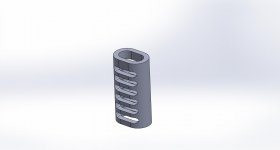Having trouble eliminating chatter marks in a deep pocket.
Material is 6061. Final depth is 2.75 inches.
Using a 1/2" 6-flute HSS end mill with 3 inch flute length.
Pocket geometry is 0.6 x 1.075.
Machine is a Kitamura MyCenter0. BT30 spindle.
I first hog the material out by drilling and then rough it with the end mill leaving 0.010 for a finish pass.
I've tried multiple combinations of speed/feed and still end up with chatter marks.
I also have a 11.5mm carbide 4-flute end mill that I could use if that would be better. Also wondered if conventional cutting on the finish pass would help?
Any help would be much appreciated.
gm
Material is 6061. Final depth is 2.75 inches.
Using a 1/2" 6-flute HSS end mill with 3 inch flute length.
Pocket geometry is 0.6 x 1.075.
Machine is a Kitamura MyCenter0. BT30 spindle.
I first hog the material out by drilling and then rough it with the end mill leaving 0.010 for a finish pass.
I've tried multiple combinations of speed/feed and still end up with chatter marks.
I also have a 11.5mm carbide 4-flute end mill that I could use if that would be better. Also wondered if conventional cutting on the finish pass would help?
Any help would be much appreciated.
gm



